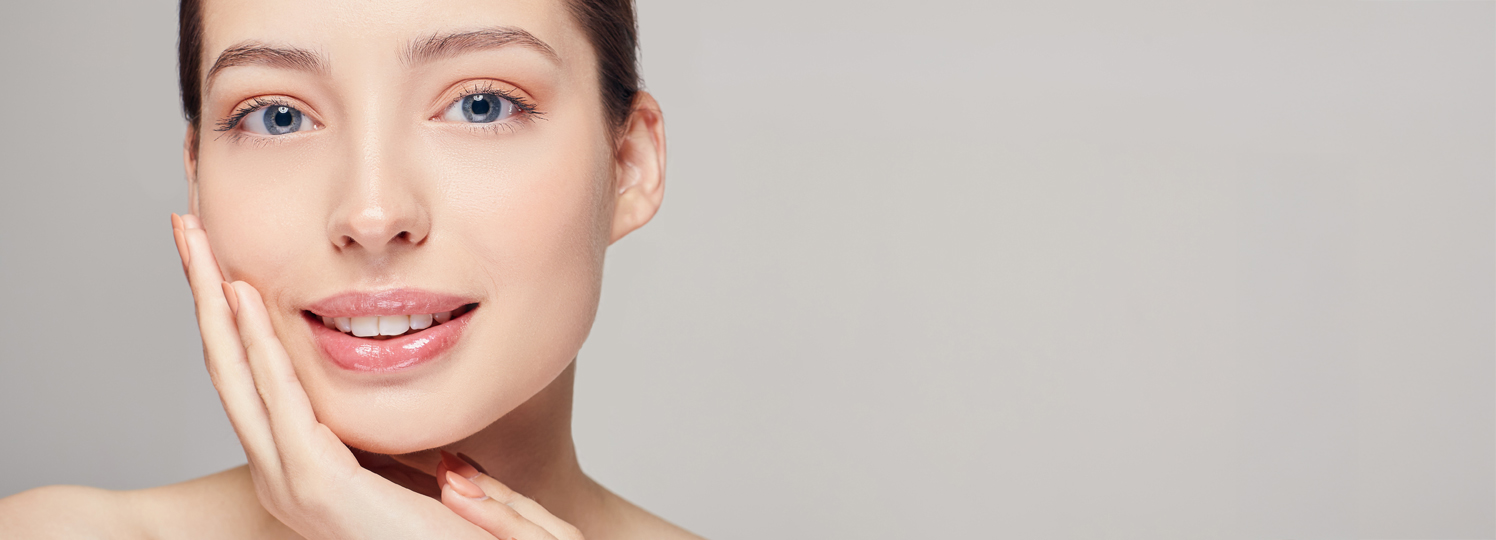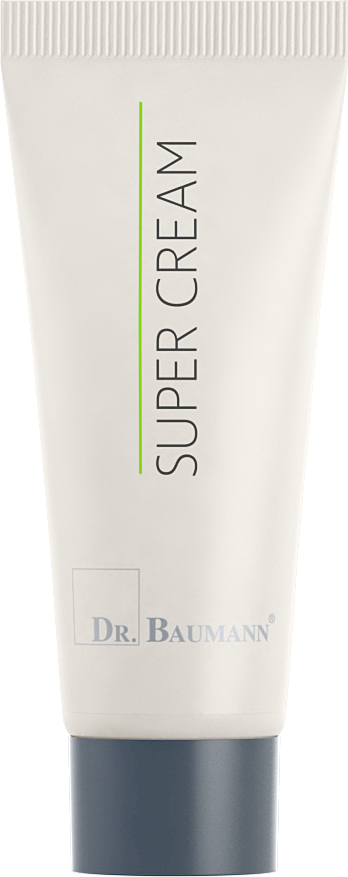

Facial Care



Facial Care
This product shows what bionome skincare can do! The rich yet light composition of oils, vitamins, lecithin and ceramides (skin-related lipids) provides the answer – better than words can describe. The SUPER CREAM contains the exact active ingredients in optimal concentrations which have been identified by the Dr. Baumann SkinIdent team, after analysis of the skin’s physiology, as the most effective and compatible. The SUPER CREAM can be used alone or preferably after the application of a DR. BAUMANN liposome treatment. (E.g. LIPOSOME MULTI ACTIVE Super Cure).
Application: To achieve the best success with DR. BAUMANN facial care, before applying an appropriate DR. BAUMANN cream, one of the LIPOSOME MULTI ACTIVE products (see basic care) should be applied.
30 ml Jar
Art.-Nr. 1006
10 ml Tube
Art.-Nr. 1506
Aqua, Butylene Glycol, Butyrospermum Parkii Butter, Simmondsia Chinensis Oil, Caprylic/Capric Triglyceride, Stearyl Alcohol, Polyglyceryl-3 Methylglucose Distearate, Urea, D-alpha Tocopheryl Acetate, Panthenol, Sodium Lactate, Glyceryl Stearate, Sucrose Stearate, Ceramid III, D-mixed-Tocopherols, Retinyl Palmitate, Sodium Ascorbyl Phosphate, Beta Carotene, Lactic Acid, Allantoin, Oenothera Biennis Oil, Xanthan Gum
Aqua:
Water. It accounts for around 65% of the weight of the human body and is therefore of fundamental importance for bodily functions, including those of the skin. In many cosmetic products (aqueous solutions, cleansers, emulsions), water is the ingredient with the largest proportion of the formulation in terms of quantity and forms the basis of the aqueous phase in emulsions. Water is a good solvent for polar (hydrophilic) substances such as alcohols, water-soluble vitamins or salts. For use in cosmetic products, the water used is generally pre-treated to remove microorganisms that could lead to spoilage of the product or dissolved salts that may impair the stability of emulsions or gels (sterilization and desalination).
Butylene Glycol:
Solvent with moisturizing effect on the skin, very good compatibility, should be preferred to propylene glycol in products used daily
Butyrospermum Parkii Butter:
Shea butter: fat from the seeds of the Butyrospermum Parkii plant. It is particularly suitable for the care of dry and sun-damaged skin. The skin becomes softer and protection against dehydration and UV radiation is built up.
Simmondsia Chinensis Oil:
Some kind of oil
Caprylic/Capric Triglyceride:
Vegetable neutral oil (triglyceride) with short-chain fatty acids. Has moisturizing properties.
Stearyl Alcohol:
A body-identical fatty alcohol, occurs as an intermediate product in fat metabolism, also present in small quantities in the epidermis. Provides consistency in emulsions.
Polyglyceryl-3 Methylglucose Distearate:
Emulsifier for O/W systems with very good skin compatibility. Obtained from glycerine, sugar and fatty acids.
Urea:
The water-soluble urea is used in numerous cosmetic products. Urea is a component of the natural moisturising factors of the horny layer (content between 7 % and 12 %; up to half lower in chronically dry skin) and has a high water-binding capacity. It contributes to sustained moisturisation of the skin and reduces transepidermal water loss. Urea has a keratoplastic effect, in higher concentrations it has a keratolytic effect and is therefore also used in the care of skin affected by psoriasis or atopic dermatitis (neurodermatitis). Urea is also able to reduce the irritating potential of surfactants.
D-alpha Tocopheryl Acetate:
Natural vitamin E acetate; storage form in the skin, is converted into the active form by dissolving the acetate bond; antioxidant with skin-protecting properties, e.g. against UV radiation, retains moisture, delays premature skin ageing
Panthenol:
D-panthenol = provitamin B5: Improves and increases the skin's ability to retain moisture, has an anti-inflammatory effect, reduces or inhibits itching. Stimulation of epithelialization: Small wounds (shaving), skin abrasions, blisters heal better. When used in hair care products, it is not only deposited on the hair and scalp, it also penetrates them and has a long-term effect. As pantothenic acid is an important component of healthy hair, the precursor D-panthenol serves as “food for the hair” according to scientific studies. It provides the hair with long-lasting moisture, improves the combability of the hair, reduces the formation of split ends, improves the condition of damaged hair, thickens the hair and gives it shine. The brittleness of fingernails is reduced.
Sodium Lactate:
Sodium salt of lactic acid: Has a moisturising effect on the skin, with the physiological pH value of the skin averaging 5.5. Important component of the natural moisturising factor (NMF) and the acid mantle of the skin.
Glyceryl Stearate:
Is a component of sebum, partially saponified fat, skin-protecting and moisturizing properties, consistency regulator and auxiliary emulsifier for lotions and creams.
Sucrose Stearate:
O/W emulsifier obtained from cane sugar and fat, very skin-friendly, moisturising.
Ceramid III:
Important component of the epidermis, especially the upper cell layers; therefore a valuable skin-physiological component of skin care products
D-mixed-Tocopherols:
Is the name of a mixture of natural tocopherols (vitamin E; D-alpha-, beta-, gamma- and delta-tocopherol). Vitamin E is the most important skin protection vitamin, which protects the skin from UV rays and oxygen radicals.
Retinyl Palmitate:
Is the storage form of vitamin A, which is converted into free vitamin A in the skin. It stimulates cell division and therefore has a strong regenerative effect, particularly on pre-aged skin and with prolonged use. Studies have even shown an increase in the collagen content of the skin, a slight reduction in wrinkles and an increase in skin elasticity.
Sodium Ascorbyl Phosphate:
Highly effective antioxidant and vitamin C donor for the skin
Storage form of vitamin C as a phosphate ester. Water-soluble vitamin with antioxidant properties. It acts against cell-damaging free radicals, protects unsaturated fatty acids from oxidation, is essential for the formation of collagen and thus the entire connective tissue as well as for the function of the immune system. Together with vitamin E, it is very suitable for preventing the formation of nitrosamines.
Beta Carotene:
Provitamin A: Fat-soluble vitamin with antioxidant properties, acts against photooxidative stress caused by sun exposure, cell-damaging free radicals, protects unsaturated fatty acids from oxidation, is skin-protecting and skin-regenerating.
Lactic Acid:
Lactic acid. Occurs as a metabolic product in the body and on the skin, has a peeling effect on the horny layer in higher concentrations and at a low pH value of 2 to 3, supports the moisture content in buffered form (physiological pH value of the skin approx. 5.5) and preserves the skin's protective acid mantle.
Allantoin:
Allantoin is a body-identical, water-soluble substance and is chemically related to urea. It is found in various plants but is now produced synthetically for use in cosmetics. Its most important property is the stimulation of new cell formation. It promotes collagen formation, skin regeneration and wound healing, stimulates desquamation, smoothes the skin and can have a soothing effect on atopic dermatitis.
Oenothera Biennis Oil:
Evening primrose oil: One of the most valuable oils for skin care. With its high concentrations of highly unsaturated fatty acids linoleic acid and gamma-linolenic acid, it is effective against dry, rough and flaky skin. It is moisturizing, has a soothing effect on the skin, increases blood circulation and counteracts the formation of pimples. In many people, the metabolic step from linoleic acid to gamma-linolenic acid is disturbed, which in extreme cases results in neurodermatitis. This is why evening primrose oil is also very popular in naturopathy.
Xanthan Gum:
Polysaccharide, natural gelling agent with very good skin-compatible properties, is obtained biotechnologically.